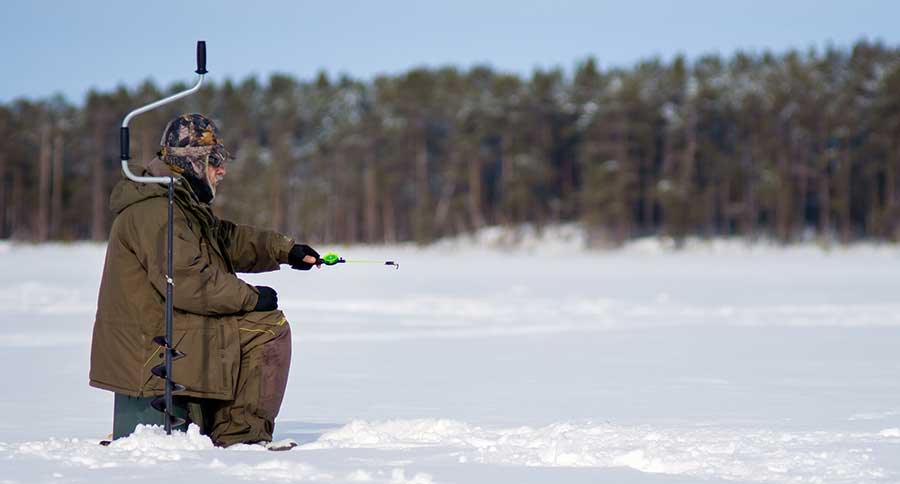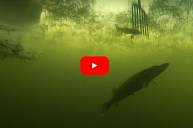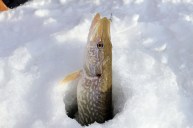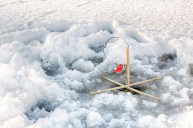Ice fishing isn't as complicated as you might think.
So, you want to try ice fishing, but you've never stepped foot on a frozen lake in your life? Have you spent your whole life in the south fishing in the warmth all year round? Well, you're in for a shock when those cold temperatures hit you.
If you've never tried it before you may have no idea what to do for your first ice fishing adventure.
Ice fishing is a lot simpler than it first appears, but it can be a bit daunting the first time you head out.
Don't worry we're here to help you catch the big one (and we'll help you avoid frostbite while you're at it!).
Safety first!
Let's get serious for a moment and talk ice safety. Because if you fall into open water, it can take only minutes to die from hypothermia, and no one wants that.
Most state agencies recommend a minimum of four inches of ice for fishing. Five inches will support a snowmobile. For anything larger, like an automobile, you need ice that is at least eight inches thick. For larger, heavier trucks, some agencies recommend 15 inches.
Before you even step on the ice, check the ice thickness in multiple spot with an ice spade. If in doubt, don't go out on it!
All anglers should make sure they have some ice safety picks around their neck too. These a simple and very cheap little tool that could save your life. If you fall through, jam the picks into the ice to pull yourself out quickly and easily. Clear, blue and black ice is always going to be the strongest. White and grey on the other hand, may not be as thick or as stable as it appears. Avoid slush at all costs.
If you do happen to fall into the cold water, do NOT panic. That's the worst thing you can do. Bring your whole body into a position that is horizontal with the ice and pull with your hands while kicking. This will help get you back onto the solid part.
From there, roll until you feel the ice is thick enough to be safe again. Keeping your weight spread out is important, so don't stand up and take steps until you know you're in the clear.
Layer up
I've embedded above one of my absolute favorite ice fishing videos of all time. A couple years ago Jon B invited LunkersTV and Lake Fork Guy up to Illinois to try hard water fishing for the first time ever. A couple of Texans who have no idea what real cold weather is. What you get is one of the most disastrous fishing days you'll ever see.
Your first lesson is to not be like these guys, a couple of clueless Texans wearing cowboy boots, blue jeans and flannel during your fishing trip! Head to the local sporting goods store and pick up a good pair of winter bibs or coveralls. This may be the most important piece of ice fishing gear that you'll buy.
We recommend these options because the problem with a jacket and pants is that you end up with a seam at your waist where body heat can escape, and cold air can enter. With bibs and overalls, you'll never have that problem. Plus, if you wear blue jeans out ice fishing, everyone on the lake will know you're a total greenhorn who has no clue what he or she is doing!
Veteran ice fishermen know, beating the cold is a big part of the adventure. The elements are seldom going to be kind to you when the fish are biting. Consider wool lined products for the most warmth. If you're going to be out in the open without the cover of a shanty, make sure your gear is waterproof and wind proof.
Don't forget a good pair of heavy, waterproof boots. Some ice cleats aren't a bad idea either to help keep your footing. Clothing matters. Because the more comfortable you are, the longer you'll be able to fish!
Necessary Gear
Many new ice fishermen are intimidated by the gear. Why wouldn't you be? If you're like us, we're sure you've already spent a small fortune on fishing gear over the years (I'm seriously afraid to add it all up).
You may start sweating while watching ice fishing videos thinking about the costs of that shanty, poles, ice augers, flashers and more. "Can I really afford another fishing habit?!?"
But truthfully, ice fishing gear isn't all that expensive. Here in the northern states, you can buy a decent spinning combo that will catch plenty of bluegills, crappie and perch for $15-20. A slightly nicer rig might cost you $40-50. Not too many ice anglers spend more than that on ice fishing rods.
If you want to try tip-up units for large fish species like walleye and northern pike, these are usually inexpensive too. I think mine were $20 at the most. Some of the more expensive ones I've seen are $40-50.
You'll obviously need an auger to cut your ice holes. Don't freak out and think you have to blow $500 on a gas-operated auger that's more powerful than that dirt bike you totaled in high school. A simple $40-50 hand ice auger will do the job in most instances quite nicely. An ice skimmer to clean the leftover ice chunks from the fishing hole might set you back $5 at the most.
Don't feel like you NEED to buy a fancy flasher unit right off the bat. Yes, they will make it much easier to find and catch fish, but it is something you can hold off on for a little bit. We recommend going out with a buddy who already owns one, or hitting a spot you know is likely to hold fish (even if you've only fished it during the spring, summer, or fall).
Two of the most vital things you're going to buy will probably be fishing line and any lures or bait you'll use. For most panfish, you can get away with two or four-pound test line. For lures, you'll be looking at a variety of jigs and spoons that are made for vertical jigging. Live baits are mostly waxworms and minnows.
We recommend starting small and cheap on ice fishing gear to make sure you'll enjoy it at first. Once you're hooked, you can start focusing on buying some better gear.
Heading out for the first time
Now that you have your fishing gear and you are wearing more layers than an Eskimo, it's time to start fishing.
Remember, you can't cover water as quickly as you can from a boat. So, instead of running around the lake like an idiot turning the ice into Swiss cheese with your auger, you need to think strategically.
Start with a lake you've fished before in the warmer months. If you can find the deep points, weed lines and structure again in the colder months, you'll be in business. It may take a little trial and error to figure things out. That's why we recommend going with a buddy, preferably one who owns a flasher and or an underwater camera to help locate the fish.
And hopefully it's someone who won't double over laughing at you when you slip and fall on your butt because you disregarded my earlier advice on the ice cleats.
But seriously, an experienced ice angler will be able to show you some of the finer points of ice fishing. Many lake anglers have local tips and tactics that you won't find anywhere else. For the ones who are reluctant to share what they're biting on, we find offering a cold one in exchange for intel may get them to offer some sage advice.
Often, especially for most panfish, you're going to be fishing right off the bottom. The fish will usually hold wherever the water is the warmest. For most presentations, you want to present your bait or jig slightly above where they are holding. This is where electronics are helpful, because they can help pinpoint exactly how deep those fish are.
Ice fishing is much like any other form of angling in that you must find the right pattern. It may take a little experimenting with colors and bait types to find that fish are hitting one colored jig more than another.
When fishing live bait, the livelier the better! Fish are going to be much more sluggish this time of year and you've got to give them a darn good reason to hit whatever it is you're presenting. Minnows and shiners that dart erratically on the hook are going to be much more enticing.
Speaking of fish being sluggish, don't be afraid to downsize the lure or bait you're using. Sure, you hammered the northerns all summer at this lake using giant spinnerbaits with blades the size of hubcaps. But you'd be surprised at the small minnows or shad those same fish will grab during the winter months. Sometimes downsizing your bait is the only way to draw a strike.
Your first ice fishing trip may not be the most pleasant. You may experience something of a learning curve, but that's part of the fun of ice fishing. You're learning an entirely different set of angling skills.
Once that first fish strikes, you'll understand what all the fuss is about, and you'll understand why so many anglers every year get so excited for that first fishable ice!
For more outdoor content from Travis Smola, be sure to follow him on Twitter and check out his Geocaching and Outdoors with Travis Youtube channels.
NEXT: 2 MINUTES OF RAPID FIRE QUESTIONS WITH MIKE IACONELLI
WATCH




